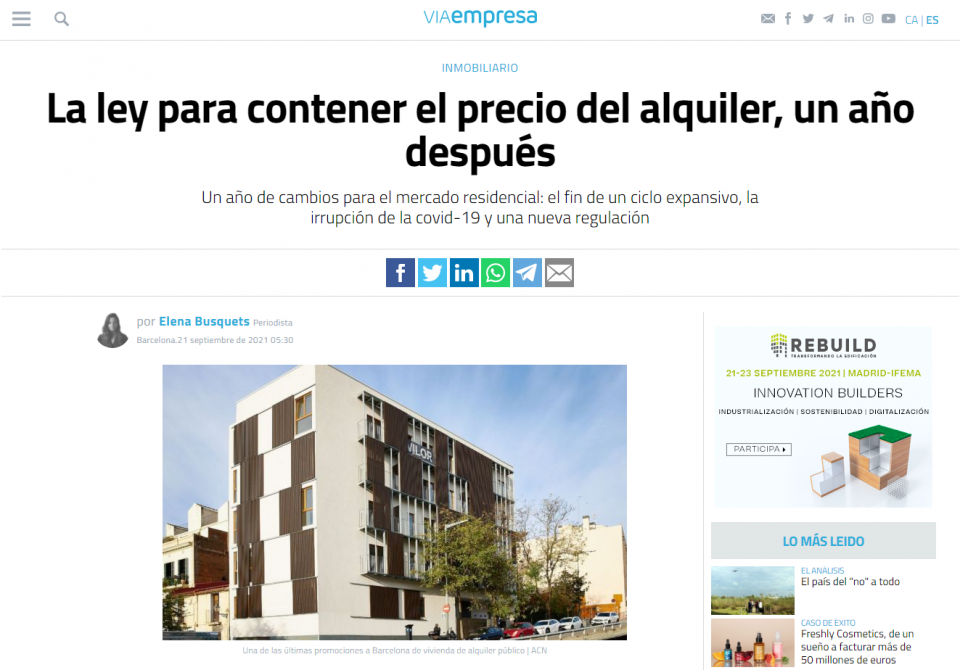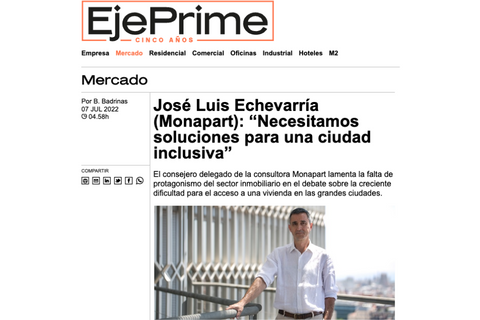Monapart in VIA Empresa: the rental price law, one year later
Eduard Solé, partner and operations director at Monapart, shares some of our conclusions and proposals for legislation with much room for improvement.
It has been a year since the passing of the law to regulate the price of rental in Catalonia, in a period full of changes for the residential sector: the end of an expansive cycle, the irruption of the COVID-19 and a new regulation, and many of you have asked us how it has affected the market and if it is serving its purpose.
In this article published yesterday, 21 September, VIA Empresa talks about The law to contain the price of rent, one year later. And for this, the journalist Elena Busquets has interviewed Eduard Solé, partner and operations director at Monapart, where he shares some of our conclusions and proposals for a legislation with a lot of room for improvement:

The law to contain the price of rent, one year later | 21/09/2021 | Elena Busquets (Via Empresa)
The law to contain the prices of rented housing in Catalonia is one year old today. Twelve months have passed since the Generalitat decided to put a brake on the rise in prices in a market that had been accumulating continuous increases since 2014. The measure affected 61 municipalities considered to be areas with a tense housing market: among them Barcelona, cities in its metropolitan area and some provincial capitals.
One year and a pandemic later, rental housing prices in Barcelona have fallen by 10%But they have also done so in other cities such as Madrid (10%), Valencia (9.5%) or Seville (8.4%), where law 11/2020 is not in force. So, what has caused prices to fall?
"We have to bear in mind that this law came at the end of a cycle".explains Lázaro Cubero, director of analysis at Tecnocasa. "The real estate market, both for sale and for rent, moves in cycles of 5-6 years and the residential market in Barcelona was just going through these years of growth". In fact, the price per square metre in the Catalan capital had increased by 46.5% from 2014 to 2019, from 10.16 euros to 14.9. In addition to the end of a cycle, there is also the irruption of the covid-19 and its impact on the economy.

Value-added penalty
According to the law 11/2020, the prices of flats have to be established according to the reference index, which takes into account aspects such as the surface area, the state of the property, the energy efficiency and the location. But what is not sufficiently taken into account, for many experts, are the extras that the property may have.
The new regulation states that the final rental price can be increased by 5% if the property has at least three outstanding features, such as a lift, special views, communal pool, furniture, etcetera. "This increase would be correct if it were for each special element of the floor, but it is insufficient if it is only achieved with three of these characteristics", analyses Eduard Solé, partner and director of operations at Monapart. He adds: "If a flat with a quality refurbishment has to have the same price as one with a botched job, owners will not be motivated to make quality refurbishments. And this could lead to the mediocrity of Barcelona's residential stock".
Eduard Solé: "If a flat with a quality renovation has to have the same price as a flat with a botched job, owners will not be motivated to make quality renovations.
Barcelona and Madrid take different paths
One of the great fears of experts in the real estate sector when law 11/2020 came into force was that there would be a reduction in supply. But the rotation produced due to covid-19 and the transfer of tourist rental flats to the traditional residential market did not allow this to happen. In fact, in both Barcelona and Madrid, supply increased from April 2020 until last July, at which point the two cities have taken different paths. While Madrid has continued to increase its portfolio of available rental flats, Barcelona has reduced it below the 2020 volume. "But it is still too early to impute this reduction to this law", says Cubero, "We have to wait longer".
Cubero of Tecnocasa is concerned that supply will continue to shrink over the years, bearing in mind that the percentage of the investor profile in property sales in Barcelona is lower than in other cities in Spain. "In Spain, two out of every ten flat purchases are made as an investment. In Madrid the investor represents 28% of the sales and purchases, in Zaragoza 26%, but in Barcelona only 16%".
This is a percentage that has not always been so low, but reflects a downward trend. "In 2018 it was around 30%. -Cubero explains. and this means that fewer and fewer people are buying in Barcelona with the aim of renting a flat, a fact that will not have an impact on the current supply, but will have an impact on future supply".
Moreover, Barcelona's homes do not belong to large holders: only 5% of Barcelona's flats are owned by investment funds, socimis or large holders. "Therefore, this law has affected small landowners in a very strong way", analyses Solé.
Holland, United Kingdom, France... and Barcelona?
For Cubero, "Barcelona will have a serious supply problem if it does not expand its public rental housing stock".. In fact, according to a study carried out by the Esade Real Estate Club and Professor Josep Oliver, Spain has the lowest social housing stock in Europe: public housing accounts for 1.1% of the country's residential stock. In the Netherlands 38%, in the UK 17.4% and in France 14%.





